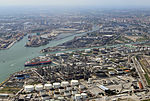Orto Botanico Locatelli
Botanical gardens in ItalyBuildings and structures in VeniceGardens in VenetoItalian garden stubsItaly geography stubs
The Orto Botanico Locatelli (300 m2) is a small botanical garden located in the northeastern corner of the Parco della Bissuola (Parco Albanese), Mestre, Veneto, Italy. It is open Sunday evenings from May to October The garden aims to integrate botany, ecology, and philosophy. It contains about 250 species organized into the following sections: medicinal plants (about 60 species), trees and shrubs of the Venetian landscape, vegetables and fruits, and a small collection of ornamental plants. It also contains a small covered area, about forty seats, which serves as a site for lectures and short courses on botanical subjects.
Excerpt from the Wikipedia article Orto Botanico Locatelli (License: CC BY-SA 3.0, Authors).Orto Botanico Locatelli
Via Rielta, Venice Bissuola
Geographical coordinates (GPS) Address Nearby Places Show on map
Geographical coordinates (GPS)
| Latitude | Longitude |
|---|---|
| N 45.501797 ° | E 12.266011 ° |
Address
Via Rielta
Via Rielta
30173 Venice, Bissuola
Veneto, Italy
Open on Google Maps










